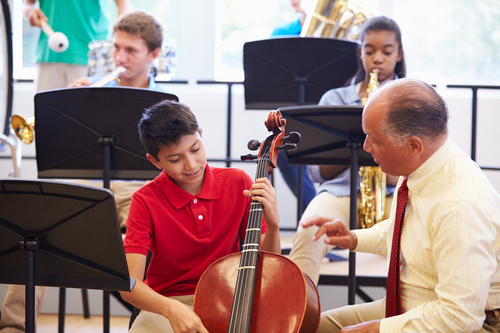
Rebuilding a Cancelled Music Program via Community Resources

Budget cuts might be the most disheartening situation a school community has to face. Cuts have become ubiquitous in public schools, even in communities unaccustomed to compromising according to financial constraints. With cuts come casualties. Unfortunately, music programs frequently become fodder for reductions. In a climate so heavily focused on literacy and mathematics performance, budget-conscious administrators and board members have come to view music instruction as a necessary concession. Other stakeholders might take exception, but might not have much of a say.
Many public schools have lost music programs in recent years. The losses have left students and parents scrambling for outlets to fill the void for music instruction. School officials can be at just as much of a loss for how to economically provide what a teacher in a funded program had overseen. Cutting a program might have been necessary, but this doesn’t necessarily mean music instruction has to stop. All involved might need to think differently about what shape music instruction needs to take. Most importantly, they need to think laterally about resources.
While an absent music program can’t be replaced, parents can work with the school to find viable ways of continuing some form of worthwhile music instruction. Some solutions might exist in the community. Others might require the creative incorporation of technology. The key is remaining optimistic, open, and engaged so that stakeholders can work constructively through a negative situation.
What follows is a series of suggestions for how parents and school officials might be able to reconstruct a music program following round of budget cuts.
1. Musicians in the community
Local instrumental music teachers might be willing to provide instruction as rotating volunteers. Not all will do this, as they need to make a living. Retired music teachers or those looking to expand their upstart music schools might be willing and able to contribute their time and talent to help individual students or small groups.
Likewise, music students or (especially) music education students from nearby universities might leap at the chance to work with students in schools. Doing so would give them an invaluable and authentic resume-building experience. Depending on the scope of a university’s music department, a partnership might be possible. The university might be able to send students every semester, resulting in a sustainable program.
Finally, a local theater company might be willing to get involved. The company might have musicians who are willing to volunteer, but the partnership could become broader. Again, depending on the theater’s scope, a multidisciplinary production might be possible. This could take the place of musical performances formerly sponsored and produced by the school’s music program. If time can be made, the school could work with the company to craft an original production that would incorporate curricular elements such as literacy (writing and editing the book), mathematics (budgeting and set design), and transitional skills (promotion and production logistics). All of this might be pleasing to an administrator if the ultimate cost to the school is little to nothing.
2. Grant writing
Grant writing is integral to many school programs. This is how much of the technology used in schools makes its way through the doors. Some teachers are well versed in grant writing. Parent organizations can identify those teachers and partner with them to author grants. The grants most likely would be for instruments. The ideas outlined above are ways to get interested, talented people to work with the school to provide instruction. Funding will remain necessary for purchasing new instruments. Grants can help with this.
A quick search online will yield dozens of opportunities for grants. Even well funded school music programs rely on grants for purchasing and maintaining expensive instruments. Teachers don’t have to be involved in writing the grants, but they might have experience that can improve the chances of securing funding. Seeking assistance in this way is common, but it becomes vital if school funding evaporates.
A parent organization might be able to seek funding through other means. Local philanthropists could be a start. Again, teachers possibly could assist with drafting proposals, especially in terms of cataloging what specific equipment is needed and why. Several benefactors could be sought. Perhaps each could be asked to sponsor something specific (paying for charter bus service; buying uniforms). The school community risks little by asking.
3. Virtual options
In the absence of a salaried music instructor, the school community might be able to turn to technology. Online resources abound for instruction for every instrument. Much of what is available is free and can be streamed. Quality varies significantly, so someone would need to preselect modules for students to use (those university students might be able to help with this). Students could learn techniques on their own time and possibly work on refining these with volunteers. With some instruments, virtual instruction could work during the school day with little interruption to other classes (think keyboards and headphones).
Nothing truly can replace an adequately funded music program led by a dedicated and knowledgeable instructor. Shrinking budgets and reordered priorities can make the former a bygone luxury. Parents and school officials aren’t without hope. The strategies above could result in meaningful educational experiences for students. Other options exist of course, many involving parents sending students for private lessons or to specialty schools of some kind. Working within the paradigm of the budget-strained public school is still a viable possibility. Sometimes surprising and impressive results spring from adversity. No one can predict from where inspiration will emerge.
Written by Jeff Hartman



